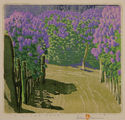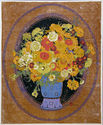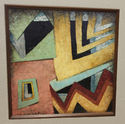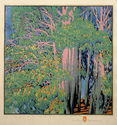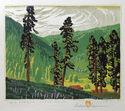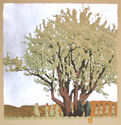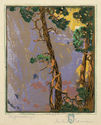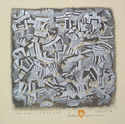
19th, 20th & 21st Century Fine Prints
707-546-7352 · fax 707-546-7924 · web: www.annexgalleries.com · email: artannex@aol.com
Gustave Baumann Biography
Gustave Baumann
American
1881–1971
Biography
Gustave Baumann was born in Magdeburg, Germany on June 27, 1881. In 1891 his family set sail on a steamer bound for the United States. After their arrival in New York they took a train to Chicago to begin a new life. Baumann was ten years old at the time but manhood was just around the corner. With the departure of his father from the family in 1896, young Gustave felt the responsibility of earning a living. With an ad in hand and drawings under his arm, he knocked on the doors of the commercial engraving houses in Chicago. He was hired as an apprentice at the Franklin Engraving Company and his career in art began. Baumann also worked at the Zeese, Gandy, and Bruner engraving companies but he soon calculated that he could make more for himself if he opened his own business. In 1901, he opened his studio at 667 Osgood Street in Chicago. Night classes at the School of the Art Institute of Chicago fueled his desire to go back to Europe for an education that would free him from the commercial grind. In March 1904, he became a United States citizen and in August of the same year he boarded a steamer for Germany where he studied arts and crafts at the Kunstgewerbeschule in Munich.
Baumann returned to Chicago in December 1905 and by 1909 he and other members of the Palette and Chisel Club discovered Brown County, Indiana. Saving up $100.00 he could spend three months in Brown County, sketching and painting. In 1910 he produced a portfolio of small format color woodcuts entitled In the Hills o’ Brown and then produced some of the largest woodcuts of the time. His color woodcuts were selected for inclusion in the 1915 Panama Pacific International Exposition where he won the Gold Medal for Prints and an Honorable Mention for his Exhibit of Color Woodcuts. In the summer and fall of 1917, Baumann visited Wyoming, New York; Manhattan; and Provincetown, Massachusetts.
Many of his Chicago artist buddies had traveled to the southwest and Baumann became intrigued by their paintings and their souvenirs. They regaled him with their stories of an exotic place named Taos, New Mexico. Baumann spent the summer of 1918 in Taos sketching and painting before visiting Santa Fe. Paul Walter, the director of the Museum of New Mexico, offered him a studio in the basement of the museum. His wanderlust was satisfied as apart from numerous sketching trips over the years he remained in Santa Fe until his death on October 8, 1971.
During his ninety years, Baumann produced woodcuts, paintings, furniture, sculpture, toys, and marionettes, and wrote poetry and plays. He was the ultimate craftsman, as he loved the feel of the wood, the tool and the handmade paper he selected. His hands controlled every aspect of his craft: the carving of the blocks, the mixing of the inks and the printing of the blocks. Baumann’s sense of play is witnessed in his marionettes, toys, and sculpture. He manipulated ordinary garden gourds into whimsical animals and assembled cacti skeletons into abstract sculpture. His irreverent nature influenced the Hysterical Parade during Fiesta of September 1926 and the No Savvy Arte! show held at the Museum of New Mexico Art Gallery in February 1952.
Exhibitions of Baumann's color woodcuts circulated throughout the country in large part due to the American Federation of Arts and the National Association of Women's Clubs. He also exhibited with the New Mexico Painters, the International Print Makers, Painters and Sculptors of the Southwest, and the Hoosier Salons. Solo exhibitions of Baumann's color woodcuts were mounted in museums and libraries across the United States and his work was represented in galleries from Carmel, California to New York City.
Baumann's work is held in over 100 museum collections in the United States and Great Britain. His work is still highly sought after by museums and collectors. Further information on Gustave Baumann can be obtained by reading In A Modern Rendering The Color Woodcuts of Gustave Baumann: A Catalogue Raisonné by Gala Chamberlain with essays by Nancy E. Green and Thomas Leech; The Autobiography of Gustave Baumann edited by Martin Krause; Gustave Baumann Views of Brown County edited by Martin Krause; Gustave Baumann: Nearer to Art by Martin Krause and David Acton; Hand of a Craftsman: The Woodcut Technique of Gustave Baumann by David Acton; and Gustave Baumann's Southwest by Joseph Traugott.
On July 18, 2025, the New Mexico Museum of Art opens the first gallery for the retrospective exhibition Gustave Baumann: The Artist’s Environment. The entire exhibition will unfold over the summer with more galleries of Baumann’s work opening, until the full exhibition opens on 26 September 2025. The exhibition will feature his color woodcuts, paintings, drawings, marionettes, furniture, and sculpture. Accompanying the exhibition will be a richly illustrated catalog of essays that focus on how the environment informed Baumann's works and how Baumann’s respect for the land and the cultures of the Southwest informed his activism. For more information, visit the New Mexico Museum of Art.
Also, this coming September, the Fray Angélico Chávez History Library of the New Mexico History Museum will hold a celebration of the Gustave Baumann Archive. Due to the hard work of many at the library and photo archives, the Gustave Baumann Archive is online at Gustave Baumann Discovery Garden. The plans are still in progress but the event is scheduled to take place on 28 September 2025.

